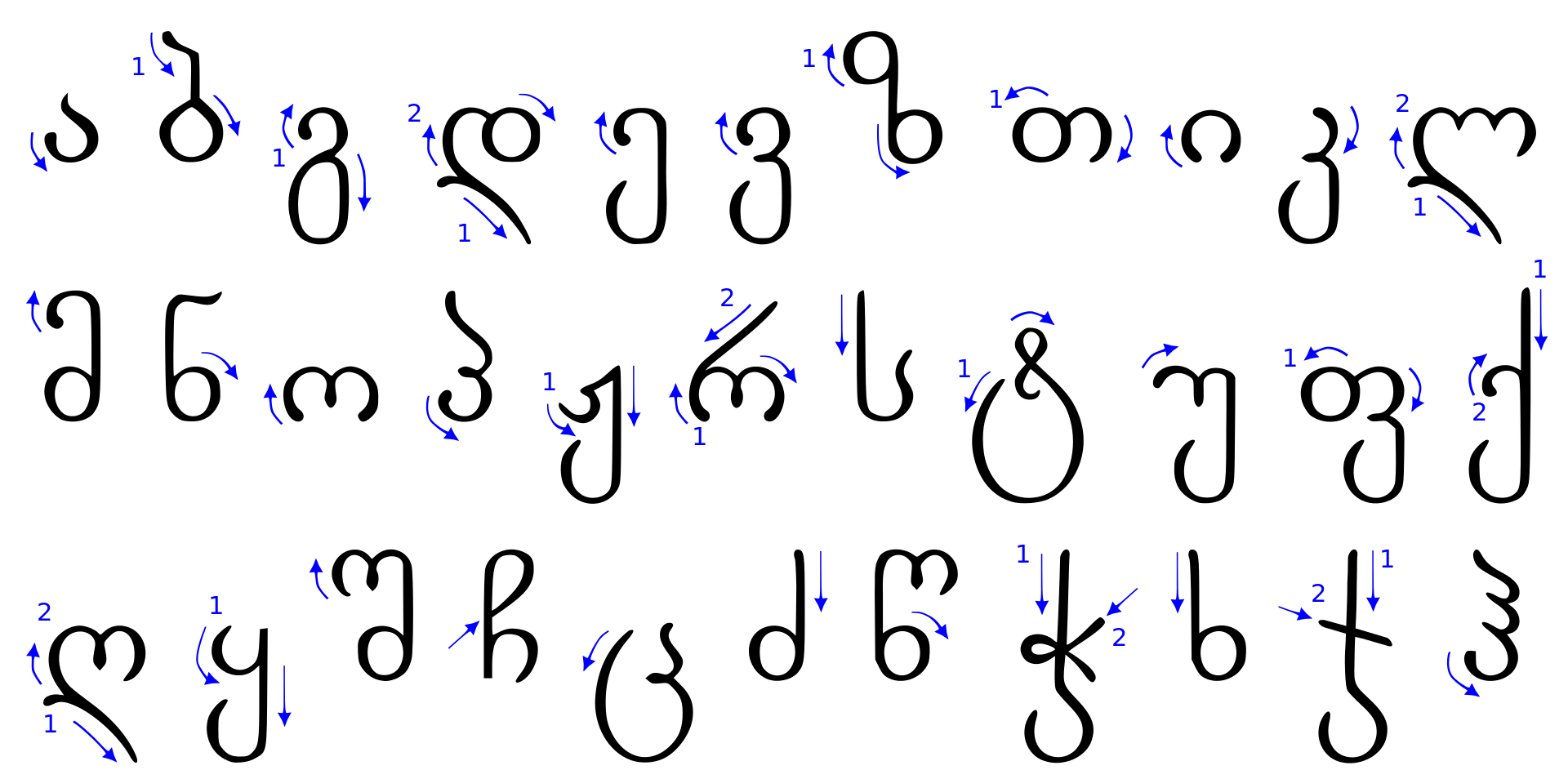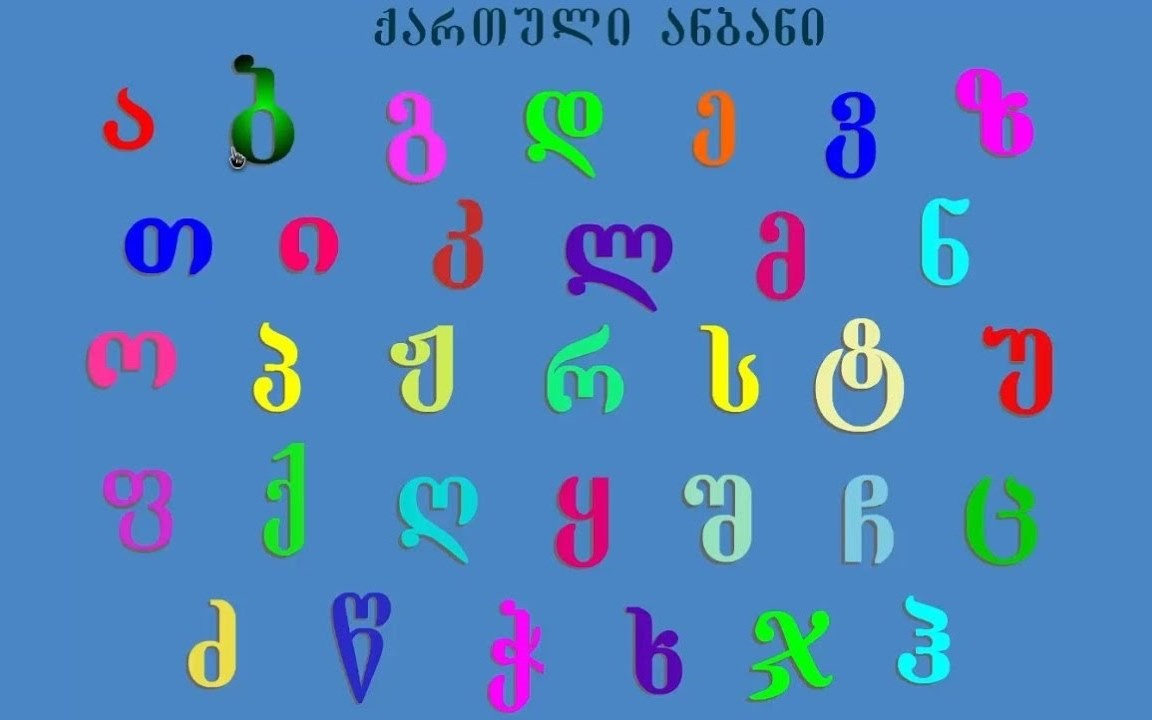The Georgian language is spoken by more than four million people. Therefore, the Georgian Alphabet is unique and has no similarity to any other alphabet in the world. There are three Georgian alphabets:
- Asomtavruli (from III BC –till IX AC)
- Nuskhuri (from IXAC – till XVIII AC)
- Mkhedruli (from X AC till today)
The first two alphabets can meet in religious inscriptions. Unfortunately, many Georgians cannot read them. All three Alphabets are written from left to right. Initially, there were 38 letters in all three Georgian alphabets, but at the beginning of the XIX century, 5 letters were removed from the modern Mkhedruli, which is no longer used in modern Georgian.
The first known Georgian texts are inscriptions from the 5th century. The Georgian national epic, The Knight in the Panther’s Skin, by Shota Rustaveli, dates from the 12th century. Modern Georgian is considered to have emerged in the 17th century.
Modern Georgian alphabet
| N | Letters | Name of Letter |
Transliteration |
|
1 |
ა | an | a |
|
2 |
ბ | ban |
b |
|
3 |
გ | gan | g |
| 4 | დ | don |
d |
|
5 |
ე | en | e |
| 6 | ვ | vin |
v |
|
7 |
ზ | zen | z |
|
8 |
თ | tan | t |
|
9 |
ი | in |
i |
| 10 | კ | k’an |
k’ |
| 11 | ლ | las |
l |
|
12 |
მ | man | m |
|
13 |
ნ | nar | n |
| 14 | ო | on |
o |
| 15 | პ | p’ar |
p’ |
|
16 |
ჟ | zhan | zh |
|
17 |
რ | rae | r |
| 18 | ს | san |
s |
| 19 | ტ | t’ar |
t’ |
|
20 |
უ | un | u |
|
21 |
ფ | par | p |
|
22 |
ქ | kan |
k |
| 23 | ღ | ghan |
gh |
|
24 |
ყ | q’ar |
q’ |
|
25 |
შ | shin | sh |
|
26 |
ჩ | chin |
ch |
|
27 |
ც | stan |
ts |
| 28 | ძ | dzil |
dz |
| 29 | წ | ts’il |
ts’ |
|
30 |
ჭ | ch’ar | ch’ |
| 31 | ხ | xan |
x |
|
32 |
ჯ | jan |
j |
| 33 | ჰ | hae |
h |
- The Georgian alphabet consists of 33 letters. 5 are vowels (numbers 1, 5, 9, 14, and 20 in the list below), and 28 consonants.
- Each letter denotes a single sound; the letter combinations in the list above (numbers 16, 23, 25, 26, 27, 28, 29, and 30) are used to approximate the corresponding English sounds. These combinations are used in transliterating Georgian words into English.
- Each letter of a word is pronounced; there are no mute letters similar to the English final -e.
- There are no capital letters.
- The stress (very light!) is always on the first syllable.
- Like English, Georgian is read and written from left to right.
There is no doubt that phonetically Georgian is very challenging, but don’t get discouraged if you can’t produce every sound. It’s very important to recognize and hear the difference between each sound. Unlike English, all syllables in Georgian are pronounced almost equally distinctly. In the beginning, your pronunciation might not be perfect, but with practice and time, you will sound like a native speaker.
Let’s start with Vowels. There are 5 Vowels: ა, ე, ი, ო, უ (a, e, i, o, u)
| Vowel | Sound | Transliteration | Examples in English | Georgian words |
| ა | ah | a | Arkansas, Argentina | მამა [mama] father |
| ე | eh | e | Ecuador, Eritrea | თითი [titi] finger |
| ი | ee | i | Italy, India, Greece | ენა [ena] tongue |
| ო | oh | o | Oregon, Norway | ორმო [ormo] ditch |
| უ | oo | u | Uzbekistan, Cameroon | უთო [uto] iron |
Do you know that?
Pharnavaz I was the first king of an ancient Georgian kingdom known as Iberia. He ruled in the 3rd century BC: 302–237 BC. He defeated the Macedonians and united the east and west kingdoms and made a strong centralized state. His name is connected to the creation of the first alphabet of Georgia. Pharnavaz is also said to have patterned his administration upon an “Iranian” model. He reigned for 65 years and was the longest ruler in Georgian history. He was the founder of the first Georgian royal dynasty named Pharnavazian.
These 20 consonants (b, g, d, v, z, t, l, m, n, zh, r, s, p, k, sh, ch, ts, dz, j, h) have English equivalent and thus they aren’t too difficult to pronounce.
| Vowel | Sound | Transliteration | Examples in English | Georgian words |
| ბ | buh | b | Bob, bed, boy | ბებია [bebia] grandma |
| გ | guh | g | go, goal, gun | გეგმა [gegma] plan |
| დ | duh | d | day, dog, dig | დედა [deda] mother |
| ვ | vuh | v | visa, Vendee, very | ვადა [vada] deadline |
| ზ | zuh | z | zebra, zoo, zigzag | ზიგზაგი [zigzag] zigzag |
| თ | tuh (aspirated) | t | Tom, ten, but | თათი [tati] paw |
| ლ | luh | l | love, luck, look | ლომი [lomi] lion |
| მ | muh | m | Mom, milk, man | მამა [mama] father |
| ნ | nuh | n | no, never, none | ნავი [navi] boat |
| ჟ | zhuh | zh | pleasure, treasure | ჟოლო [zholo] raspberry |
| რ | ruh (rolled r) | r | brilliant, rat, red | რა [ra] what |
| ს | suh (aspirated) | s | Stan, salad, stain | სიო [sio] breeze |
| ფ | puh (aspirated) | f | pencil, soap, soup | ფაფა [papa] porridge |
| ქ | kuh (aspirated) | k | Cat, book, cook | ქალი [kali] woman |
| შ | shuh | sh | Shore | შუშა [shusha] glass |
| ჩ | chuh | ch | Church | ჩაი [chai] tea |
| ც | tsuh | ts | Cincinnati, pizza | ცა [tsa] sky |
| ძ | dzuh | dz | roads, kudzu | ძიძა [dzidza] babysitter |
| ჯ | juh | j | June, July, and January | ჯუჯა [juja] dwarf |
| ჰ | huh | h | home, hair, hot | ჰავა [hava] Climate |
Some Georgian sounds might sound similar, but they aren’t. Confusing each other sometimes changes the meaning of a word. Some of these sounds are voiceless, or aspirated (when you breathe out at the same time), the others are voiced, or unaspirated (when you don’t breathe at the same time)
| Consonants | Sound | Transliteration | Examples in English | Georgian words |
| კ | kuh (unaspirated) | k’ | bake, take | კალამი [kalami] pen |
| პ | puh (unaspirated) | p’ | pepper, port | საპონი [saponi] soap |
| ტ | tuh (unaspirated) | t’ | Stan, stop | ატამი [at’ami] peach |
| წ | tzuh (unaspirated) | ts’ | no English equivalent | წუთი [ts’uti] minute |
| ჭ | tchuh (unaspirated) | ch’ | no English equivalent | ბიჭი [bich’i] boy |
6 pairs of consonants sound almost identical. The first sound of each pair is voiceless, the second sound is voiced (unaspirated)
| 1. | თ-ტ | 3. | ფ-პ | 5. | ჩ-ჭ |
| 2. | ქ-კ | 4. | ც-წ | 6. | ს-ზ |
Examples: Georgian Alphabet
| N | Pairs | Transliteration | Georgian words | Word pronunciation | Translation |
| 1. | თ | t (unaspirated) | თარი | [tari] | musical instrument |
| ტ | t’ (aspirated) | ტარი | [t’ari] | handle | |
| 2. | ქ | k (aspirated) | ქარი | [kari] | wind |
| კ | k’ (unaspirated) | კარი | [k’ari] | door | |
| 3. | ფ | p (aspirated) | ფული | [puli] | money |
| პ | p’ (unaspirated) | პური | [p’uri] | bread | |
| 4. | ც | ts (aspirated) | ცელი | [tseli] | grass cutter |
| წ | ts’ (unaspirated) | წელი | [ts’eli] | year | |
| 5. | ჩ | ch (aspirated) | ჩირი | [chiri] | dried fruit |
| ჭ | ch’ (unaspirated) | ჭირი | [ch’iri] | plague | |
| 6. | ს | s (aspirated) | სუსტი | [sust’i] | weak |
| ზ | z (unaspirated) | ზუსტი | [zust’i] | precise |
Do you know that?
Ilia Chavchavadze (8 November 1837 – 12 September 1907) was a Georgian figure, journalist, publisher, writer, and poet who spearheaded the revival of the Georgian national movement in the second half of the 19th century and played a major role in the creation of Georgian civil society during the Russian of Georgia. He was a devoted protector of the Georgian culture from Russification. The Society for the Spreading of Literacy among Georgians, founded by Prince Ilia Chavchavadze in 1879, discarded five letters from the Georgian alphabet that had become redundant. He is Georgia’s “most universally revered hero.
| Consonants | Sound | Transliteration | Examples in English-Georgian | Georgian words |
| ღ | rrr in a throat french | gh | French r no English equivalent | ღომი [ghomi] grits |
| ხ | guttural sound in the throat | kh | Bach, Loch-Ness | ხახა [khakha] throat |
| ყ | guttural sound deep in the throat | q’ | no English equivalent | ბაყაყი [baq’aq’i] frog |
Do you know that?
The United Nations Educational, Scientific, and Cultural Organization (UNESCO) has added the Georgian alphabet to the list of the Intangible Cultural Heritage of Humanity. The nomination was submitted to UNESCO for consideration in 2015. The main goal is to underline the harmonic co-existence of three alphabets. The UNESCO official webpage reads that the evolution of Georgia’s written language has produced three alphabets – Mrgvlovani, Nuskhuri, and Mkhedruli – which all remain in use today. Mrgvlovani and Nuskhuri are practiced and taught informally predominately by the community of the Georgian Apostolic Autocephalous Orthodox Church while Georgia’s educational system, however, is based on the Mkhedruli alphabet.
Georgian letters are written in a four-lined net as in English, but the letters have no slope. Some of the Georgian letters exceed the line upwards or downwards.

The Georgian Alphabet has some similar-looking characters and also mirrored image letters. You need to practice identifying them.[dt_divider style=”thick” /]
Similar-looking characters: Georgian Alphabet
| 1. | ლ-ღ-დ | 3. | პ–ჰ | 5. | ბ-გ |
| 2. | კ-ქ-ვ | 4. | თ-ფ |
Examples: Georgian Alphabet
| N | Pairs | Transliteration | Georgian words | Word pronunciation | Translation |
| 1. | ლ ღ დ | l gh d | ლომი ღამე დიდი | [lomi] [ghame] [didi] | lion handle handle |
| 2. | კ ქ ვ | k’ k v | ლეკვი ქმარი ვირი | [lek’vi] [kmari] [viri] | poppy husband donkey |
| 3. | პ ჰ | p’ h | პირველი ჰაერი | [p’irveli] [haeri] | first air |
| 4. | თ ფ | t p | თუთა ფუნჯი | [tuta] [punji] | mulberry brush |
| 5. | ბ გ | b g | ალუბალი გუგული | [alubali] [guguli] | cherry cuckoo |
Mirrored image letters:
| 1. | მ-ნ | 2. | ძ-ხ | 3. | შ-წ | 4. | დ-ფ |
Examples:
| N | Pairs | Transliteration | Georgian words | Word pronunciation | Translation |
| 1. | მ ნ | m n | მელანი ნისლი | [melani] [nisli] | ink fog |
| 2. | ძ ხ | dz’ kh | ძაღლი ხმალი | [dz’aghli] [khmali] | dog sword |
| 3. | შ წ | sh ts’ | შუა წერა | [shua] [ts’era] | middle writing |
| 4. | დ ფ | d p | მადა ფანჯარა | [mada] [panjara] | appetite window |
Do you know that?
The first-ever printed book in the Georgian language was the Italian-Georgian Dictionary, printed in Rome in 1629 by Niceforo Irbachi (Nicholas Irubakidze-Cholokashvili), a Georgian Orthodox priest, politician, and diplomat. Therefore, the first printing house in Tbilisi was established in 1712 and the first books printed there were The Bible, The Knight in the Panther’s Skin by Shota Rustaveli, and The Georgian Dictionary. After the annexation of Georgia by Russia in 1801 and the abolition of the Georgian Kingdom, Georgia remained a Russian province until 1918 when an independent republic was announced. During this time, Georgian did not function as a state language (until 1805, teaching Georgian at schools was also prohibited) and books were distributed only in handwritten form until 1805. The first Georgian newspaper appeared in 1819.


Customer
Good post! We will be linking to this great
post on our site. Keep up the good writing.
Customer
Very energetic post, I loved that bit. Will there be a
part 2?
Customer
It’s remarkable to go to see this site and reading the views of
all mates on the topic of this post, while I am also zealous of getting experience.